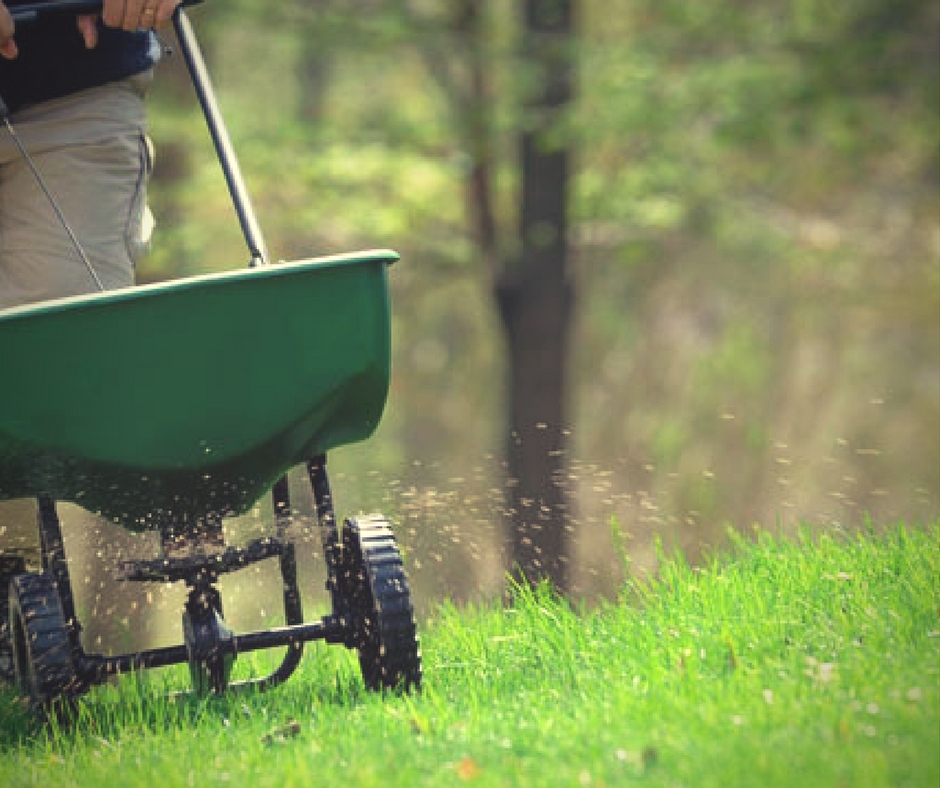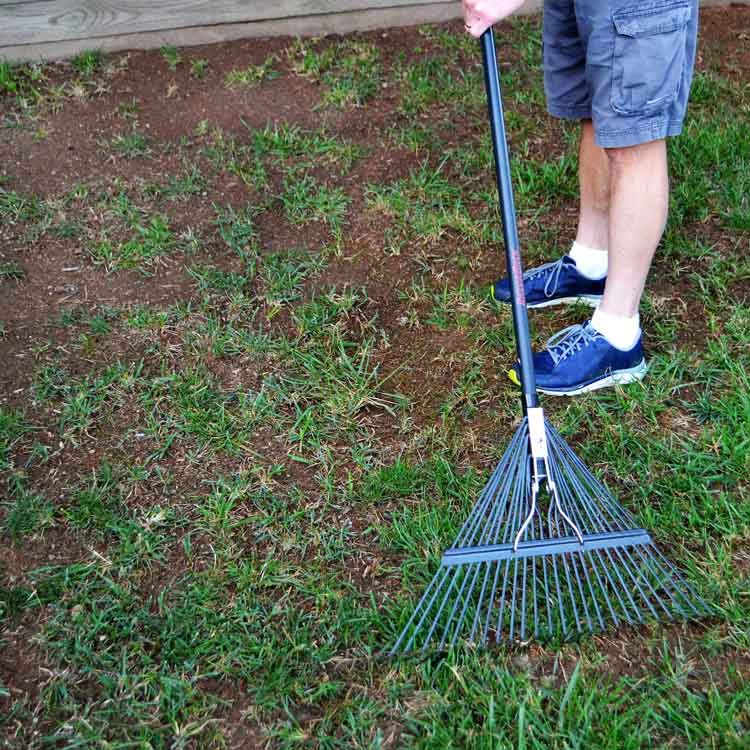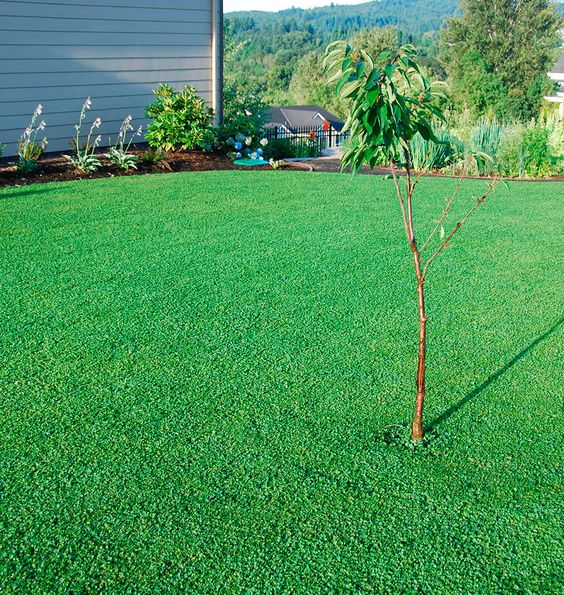When Is The Best Time For Overseeding Lawns
When to overseed lawn depends on the type of seeds you are planting. In northern climates overseeding should be performed 45 days before the planting zones first frost. This is ideal for strengthening a weak or thinning lawn. Strengthening turf in the spring is best done when the threat of all freezes has passed their region.
Those living in southern climates with warm-season grasses should overseed to obtain winter colour, when temperatures have dropped below 65 degrees at night consistently. Prepare the area properly prior during elevated soil temperatures to promote germination.
How to Overseed a Lawn
You will need:
Step One: Mow and Rake
Begin the overseeding process by mowing your lawn on the lowest setting and bagging the clippings. Next, rake the lawn to remove any loose grass or debris, further exposing the soil to accommodate the new seed.
Step Two: Amend the Soil
Add a thin layer of one-quarter of an inch or less of enriched soil over the existing grass and gently rake it in to provide a healthy environment for the new seeds to settle into.
Step Three: Add the Seeds
Fill the seed spreader and adjust the settings according to the directions on the label, and apply over the entire area, refilling as needed. For smaller areas, you may want to use a hand spreader while a drop or broadcast spreader is more suitable for larger lawns.
Step Four: Feed the Grass
Step Five: Water the Lawn
Categories:
How To Overseed Or Reseed Your Lawn Properly
Overseeding or reseeding your lawn is a great way to improve your yards overall health and appearance. By planting new grass seed, you can fill in any bald spots or thin areas and help your lawn become thicker and more resistant to weeds and pests.
There are a few things to keep in mind when overseeding or reseeding your lawn: first, be sure to remove any debris from the area where you will be planting the new seed. Next, spread the seed evenly over the site, and then use a rake or broom to gently press it into the soil. Finally, water the area well and keep it moist until the new seed has germinated.
There are a few things to keep in mind when overseeding your lawn:
- Ensure that you select a seed blend appropriate for your climate and soil type.
- Make sure to rake the existing lawn thoroughly before spreading the new seed.
- Water regularly until the new grass has germinated and taken root.
Can You Mix Different Types Of Grass Seed
Yes. Mixing different grasses is actually better than planting only one grass type. You can combine the strengths of different grass types to make your lawn more tolerant of traffic, drought, heat, or shade. You should usually stick to either warm-season grass types or cool-season grass types, except in the case of ryegrass.
For example, here are two common grass seed combinations:
- Kentucky bluegrass and fescue: Fescue is more drought -tolerant, and Kentucky bluegrass spreads to fill bare spots and repair damage. They compensate for each others weaknesses.
- Bermudagrass and perennial ryegrass: Bermuda stays green in summer while ryegrass is dormant, and ryegrass stays green in winter while Bermuda is dormant .
Also Check: How To Build A Raised Patio Deck
Return To Regular Maintenance
Keep your newly revived lawn looking its best with a regular, comprehensive maintenance plan that includes diligent watering, best mowing practices and proactive overseeding. A simple weekday lawn maintenance schedule can keep your lawn lush and your weekends free.
For a simple, all-in-one approach to a thicker lawn, you can put your lawn on the fast track with Pennington Lawn Booster. This easy-to-use product simplifies overseeding to give your lawn the boost it needs. In just one application, your lawn will grow quicker, thicker and greener than ordinary grassguaranteed.
Available in formulas for sun & shade or tall fescue lawns, Lawn Booster combines three essentials: seed, fertilizer and soil enhancer. Lime-enhanced, pure-bred Pennington Smart Seed, backed by years of breeding and research, adds beauty and sustainability. Once established, these water-conserving grasses require up to 30 percent less water than ordinary grasses. That’s year after year, for the life of your lawn. Plus, they stay green up to three weeks without watering. That means less work and more leisure time for you.
For the lawn of your dreams, don’t wait to overseed until your lawn looks less than its best. Give your lawn the boost it needs, step-by-step or all-in-one. Pennington’s here with premium grass seed and lawn care products to help you keep your lawn at its peak.
Pennington, One Step Complete, Smart Seed, and Ultragreen are trademarks of Pennington Seed, Inc.
Overseeding Your Lawn: The Checklist

Youll need the following items to overseed your lawn:
- Garden hose, sprinkler, or watering can
Are you ready to overseed your lawn?
Hopefully, you feel better informed and can confidently go about your first overseeding project. But if you have any questions, please .
We love hearing from you, and we promise to get back to you as quickly as possible. Were looking forward to hearing from you.
Thanks for reading!
Don’t Miss: How To Get Rid Of Lawn Burweed
Prepare The Area To Overseed Or Reseed Your Lawn
There are a few key things you can do in preparation for overseeding or reseeding your lawn:
- Remove any debris from the area, including leaves, branches, and stones.
- Rake the area to loosen the soil and create a smooth surface.
- Apply a layer of compost or manure to the area and rake it in.
- If youre overseeding, spread the seed evenly over the area and rake it in. Dig up the entire lawn and remove any old grass or weeds if youre reseeding. Sprinkle the new seed over the place and rake it in well.
- Water the area well until the soil is moistened completely.
- Keep the area wet until the new grass has grown in completely usually about two weeks.
When To Overseed A Lawn
First of all, you should avoid overseeding during the hottest and coldest months of the year, so that excludes summers and winters. The best time to overseed in the UK would be spring March, April and early May, or early autumn late August to September. During these months, the weather is not too hot, not too cold, there is a high chance of rain and, as we mentioned a few times already, seeds need moisture in order to germinate. If you live outside of the UK, you should consider the climate conditions in your area and plan the reseeding process accordingly.
Don’t Miss: How To Put A Solid Roof On A Metal Gazebo
When Is The Best Time To Overseed
Hands down, early fall is the best time to overseed your lawn. The absolute sweet spot for most northern regions of the U.S. is August 15 to September 15. Thats when daytime temperatures are still warm enough to encourage growth and nights get cooler, giving new seedlings a break from the heat. Lawn grasses like that. Soil temperatures are ideal, too, resulting in quicker seed germination.
But dont let missing that perfect seeding window stop you. Depending on where you live, overseeding can be done all the way through September and into early October. Weed competition is virtually nonexistent and predictable rains fall softly with few gully washers that could wipe out your efforts in 15 minutes. All these factors create the perfect late summer/early fall window for overseeding your lawn.
How To Overseed A Lawn
This article was co-authored by Keith Souza. Keith Souza is a Home Improvement Specialist and the Owner of Vaulted Hammer Handyman Services. He specializes in home repair, home automation, and yard maintenance. Keith holds an AAS in Electronics Technology from Heald College.There are 7 references cited in this article, which can be found at the bottom of the page.wikiHow marks an article as reader-approved once it receives enough positive feedback. In this case, 100% of readers who voted found the article helpful, earning it our reader-approved status. This article has been viewed 718,311 times.
Overseeding is one of the most important tasks involved in growing a healthy, lush lawn. While fertilizing your lawn is important, grass plants slow down their rates of reproduction after a few years. Over time, lawns that have not been overseeded will grow thin and unhealthy, making it much easier for weeds to overtake the lawn. Overseeding can be time-consuming if you have a large lawn, but it is not difficult, and the results are well worth it the effort.
You May Like: Porch Railings At Home Depot
When To Overseed Warm
Warm-season grasses grow most actively in the heat of late spring and summer, and they thrive in the southern half of the country. Common warm-season grasses include Bermudagrass, Zoysiagrass, centipedegrass, and St. Augustinegrass.
If youre overseeding your warm-season lawn with warm-season grass seeds, plant them in late spring or early summer, when the soil temperature is between 70 and 90 degrees.
But theres another option for overseeding warm-season grass. Many homeowners choose to add cool-season ryegrass to their lawns in fall so their lawn remains green throughout winter. If youre planting ryegrass seeds, overseed in fall, when soil temperatures are between 50 and 65 degrees.
In the extreme South, you should use annual ryegrass for winter color. It will die out in June when the temperatures start to rise.
If you live in a milder climate in the middle of the country, you can plant perennial ryegrass, which will survive and go dormant during summer and green up again next fall. That way, you dont have to keep overseeding every fall. Dont bother planting perennial ryegrass in the extreme South, though it will die in the heat just the same as the annual variety.
Spread Your Grass Seed
You need to remember a few key things when spreading grass seed to overseed or reseed your lawn:
- Make sure you are using the correct type of seed for your climate and the specific needs of your lawn.
- Be sure to water the seed properly to germinate and take root.
- Give the new grass enough time to grow before mowing it.
Apply seed at the stated overseeding rates using the appropriate lawn spreader like Scott Elite. To treat big lawns, use drop or broadcast spreaders. Small patches can be seeded by hand. Work in calm air to ensure seed distribution.
Read Also: Hampton Bay Arched Pergola Replacement Parts
Making A Plan To Overseed Or Reseed Your Lawn
If youre noticing your lawn is looking a little thin, or the color isnt as bright as it used to be, you may need to overseed or reseed your lawn. Overseeding is the process of adding new seed to an existing lawn while reseeding is planting new seed in an area that has been completely tilled.
No matter which process you choose, there are a few things youll need to do before getting started:
- Rake your lawn to remove any dead grass or debris
- Break up any clumps of soil with a rake or shovel
- Amend the soil with compost or fertilizer
- Water the area well
Once youve prepared the area, its time to choose your seed. If youre overseeding, select a blend that matches the existing grass.
Recommended Steps For Complete Renovation

Tip: Reduce the recommended seeding rate by one-half and cover the area twice, in two directions, leaving a cross-hatch seeded pattern at a 45º angle.
Note: Whether or not a chemical such as Glyphosate is used, it usually works better to overseed new grass into the old, undisturbed turf, even if it is dead, rather than start with bare dirt. Overseeding is faster and easier than completely digging up the soil, and it leaves some cover to protect against wind or water erosion of the soil surface.
Also Check: How To Make Your Own Patio Pavers
Water Your Lawn Generously
Right after spreading the seeds and fertilizer, water the lawn deeply. After that, water lightly every day to keep the soil moist while the new grass establishes. Continue watering every day until the new grass is as tall as the established grass.
Always water in the morning, before 10 a.m., to keep the water from evaporating in the heat of the sun. Watch for signs of overwatering, such as puddles or spongy soil. If you notice these signs, cut back on the watering immediately.
Think About What You Want To Accomplish With Overseeding
Most people, when they think about overseeding, think about doing it to help out a lawn that has thinned.
However, it can be best to think about overseeding as a preventative measure. Overseeding can help prevent weeds from taking over your lawn.
No matter why youre overseeding your lawn, once you have your goals straight, then you can think about how to overseed properly.
Recommended Reading: How To Close In A Patio
Its Time To Spread The Seed
Once you have prepared the area by mowing the grass, raking, and choosing your seed, it is time to spread the seed. Be sure to check the seed label to know the rate of overseeding.
Using a lawn spreader, available at most home improvement and gardening stores, spread the seed around your lawn.
Spreading the seed is a pretty self-explanatory process however, it is important to do it when the air is calm. Do NOT try to spread the seed on a windy day, as you will ultimately miss your lawn and waste your seed. Likewise, working when the air is calm ensures even distribution of the seed.
Take Care Of Your New Seed
Fertilizing your new seed is essential for its growth. Fertilizer delivers essential nutrients that help it to germinate and grow into the healthy lawn that you want.
All-natural fertilizer is the best option for fertilizing your new seed, as phosphorous supports rapid root growth however, there are restrictions on certain types of fertilizer, so be sure to check restrictions in your area.
My go-to method is to broadcast a thin layer of compost over my lawn after spreading the new seed.
Not only will this ensure good contact with your new lawn seed, it feeds your established grasses. Its pretty cheap to order a delivery and spread it with a wheelbarrow and shovel.
Read Also: Who Makes Craftsman Lawn Mowers
Dethatch And Aerate The Lawn
For new grass to grow, the seeds have to be able to reach the soil. Dethatching and aerating your lawn before spreading the seed can help with that. This step isnt absolutely necessary, but it will lead to more successful seed germination.
First, dethatch the lawn if the layer of thatch in your yard is thick enough that you cant see the soil through it. After dethatching, aerate the lawn by poking holes in the soil with a core aerator machine. You only need to aerate now if you havent done so in the past year.
Solve Existing Lawn Problems
Lawns can be a great addition to any home, but only if they are appropriately taken care of. One common issue with their lawn is that the grass is not thick or healthy-looking. This may be due to several factors, such as problems with the soil, pests or diseases, or incorrect watering habits. To correct this problem and overseed or reseed your lawn, you will need to closely look at what is causing it.
If the grass is thin or patchy, it may be due to a lack of nutrients in the soil. In this case, you can add some organic matter or fertilizer to help improve the quality of the soil. Be sure to follow the directions on the package carefully to not damage your lawn further.
You May Like: Free Standing Pergola On Concrete Patio
S To Aerating And Overseeding Your Lawn This Fall
Look, not only is aeration and overseeding an easy process, it can be fun too.
But you have to do it right, or you will be wasting your time.
To ensure you are doing things right, follow these 5 simple steps to aerate and overseed the right way.
When is the best time to Aerate?
You can aerate in the early spring or late fall. Most people get it done in the fall so that the grass seed can overwinter in the lawn.
In my experience, the best time to aerate and overseed is right after the last cutting of the lawn for the season. But if you miss the fall, early spring is good too.
Spread The Grass Seed

Before choosing a grass seed mixture, know your grass type. Use seeds for either the same type of grass already growing in your yard or a compatible grass type. Usually, compatible means cool-season grass types with other cool-season grass types and warm-season grass types with other warm-season grass types.
Fill a fertilizer spreader with your chosen grass seed mixture. Walk the spreader across your lawn in rows, following the same pattern you use when you mow. For information on how much seed to use, see the package label.
You May Like: What Is A Pergola Canopy
Plus What To Do Before & After
PostedApril 7, 2022
Even though your lawn is just starting to wake up from dormancy, a lot could have happened over the winter. If your lawn isnt bouncing back from the harsh winter temps, big changes like tree removal, or there are large bare spots for another reason, it may be time for action. Learn when to overseed your lawn and how it can help you enjoy lush, green grass this spring.